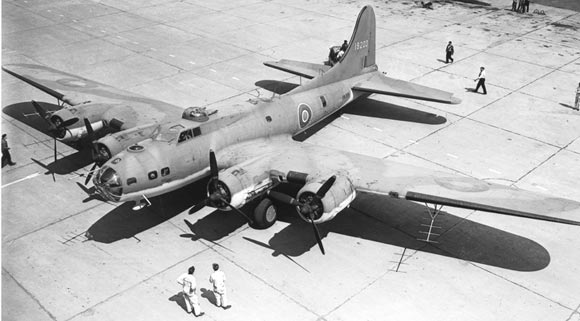
Base; RAF Chivenor
Take off time: Unknown.
Op: Anti-submarine patrol.
According to this French forum (view source) - On this day FK209 was shot down by a Ju88C of the 13./KG 40, 350 Km south west of Oussant. This was an all Canadian crew.
According to Chris Goss, an expert on Luftwaffe operations over the Bay of Biscay, FK209 was shot down at 47º42’N 06º55’W by Oblt Hermann Horstmann of 13/KG40 flying a Junkers Ju 88C. (source)
_________________________________________
The following is taken from a memorial for Sgt Arnold: (view source)
"While flying on a routine anti-submarine patrol over the Bay of Biscay (the bay which lies between Spain and France), Arnold’s aircraft, Fortress Aircraft #209 went missing. It is presumed that enemy action was involved. The other crewmembers on the plane with Arnold, were also reported missing. These include F/O Weatherhead, F/O Zapfe, Sgt. Copping, F/Sgt. Cojocar, Sgt. Spino, Sgt, Montgomery, one other crew member, whose name is not recorded.
Arnold was officially declared dead two months after the incident. His plane and body were never recovered. Not much is recorded about this incident.
However, it is known that the Bay of Biscay was a “hot spot” for German U-Boats, and it was common for Allied pilots to fly anti- submarine patrol missions. The Bay was also heavily patrolled by Coastal Commands. German submarines frequently sailed through the Bay of Biscay from four of the French ports they controlled"
_________________________________________
Weatherhead, Zapfe, Spino and Copping had previously comprised a Hudson crew in No.200 Squadron operating out of Freetown, Sierra Leone. On 16 September 1942, returning from a convoy patrol in Hudson FH288, they encountered a severe storm, became lost, and eventually crash-landed on Bolama Island (Portugese Guinea). They destroyed their aircraft and were briefly interned, but reached England once more in October 1942. The 59 Sqn ORB notes that they were posted from No. 407 Sqn (Candadian) on the 12.12.42.
All lost:
 |
Front (L-R): W/O Copping - F/O Weatherhead - F/O Zapfe (submitted by Robert Stitt) |
It appears that the 7 Canadians (pictured above) were posted to the Squadron together from No. 407 (Canadian) squadron and that P/O Phillips (who was British) accompanied this crew for the first time on this day. FK209 - J/59 had flown a mission two days earlier with F/O Murray Charlton & crew and P/O Phillips was present on this flight also (and this being the first note of him in the ORB). Both these flights had been in FK209 and it appears that P/O Phillips was a flight engineer possibly monitoring an electrical/mechanical issue that had been detected. Previous to the flight on the 21st with Charlton & crew, FK209 had not been out since the 8th. Possibly, having undergone a routine maintenance check & overhaul the issue had been detected and although not deemed severe enough to ground the aircraft, perhaps it was felt prudent that a flight engineer accompany the crew(s) to monitor the systems during operations...
______________________________________________________________
| Pilot | Co-pilot | Navigator | Unknown |
 |  |  |  |
| Unknown | Unknown | Unknown | Flight Engineer |
 |  |  |  |
During WWII, the RAF used three-letter codes to identify their aircraft from a distance. Two large letters were painted before the roundel, which signified the squadron to which the aircraft belonged, and another letter was painted after the roundel which indicated the individual aircraft. Aditionally, there was the individual serial number for each aircraft, which was painted in a much smaller size, usually somewhere at the rear of the aircraft: (more)
Codes used by RAF 59 Squadron:
PJ Sep 1938 - Sep 1939
TR Sep 1939 - Oct 1942
1 Aug 1943 - Jul 1944
WE Jul 1944 - Oct 1945
BY Oct 1945 - Jun 1946, Dec 1947 - Oct 1950